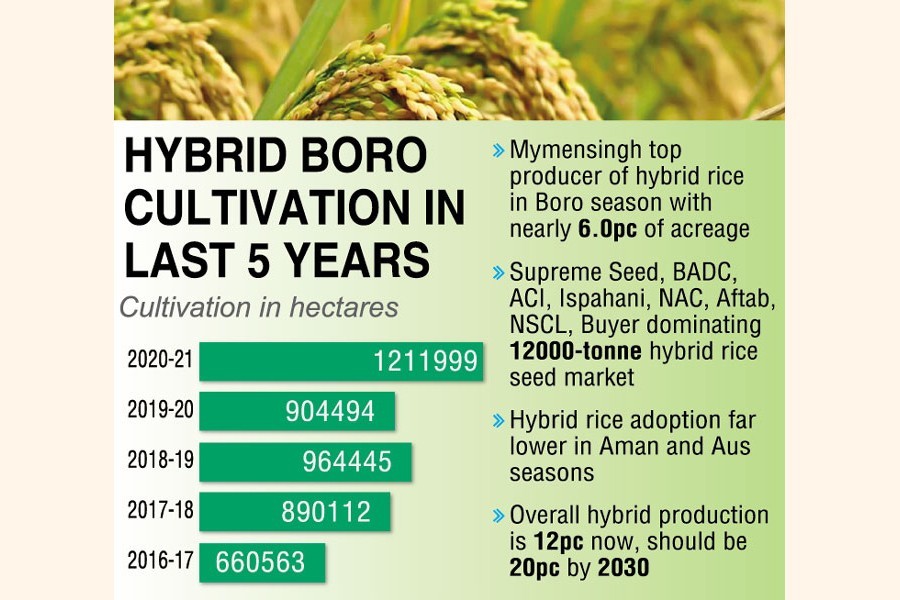The arable land under hybrid rice cultivation, especially in Boro season, almost doubled in last five years, with Mymensingh emerging as the top producer district, a latest study of the government revealed.
The Department of Agriculture Extension (DAE) conducted the study, titled "Strategies to increase cultivation of high-yielding hybrid and inbreed varieties of rice."
It showed that hybrid rice fields during the Boro season increased to 1.21 million hectares or 24.8 per cent of the total Boro acreage in financial year (FY) 2020-21.
Hybrid rice was cultivated on 0.66 million hectares of land or nearly 14 per cent of the total Boro acreage in FY 17.
The government's procuring food grains in a large quantity and developing local hybrid rice varieties, contributed largely to such growth, resulting in high production, said the study.
Twelve districts under Mymensingh, Sylhet, Rangpur and Khulna divisions are producing more than 51 per cent of the total hybrid rice output in Boro season.
Mymensingh district is on the top of the list with 68,918 hectares, followed by Noakhali 61,025 hectares, Sunamganj 57,210 hectares, Sherpur 56,453 hectares, Gopalganj 51,665 hectares, and Kurigram 51,150 hectares.
The study findings were presented at a seminar on high-yielding hybrid and inbreed rice varieties, organised recently by the Ministry of Agriculture.
Habibur Rahman Chowdhury, additional director (extension and coordination), Field Service Wing of DAE presented a paper on the occasion.
It noted that eight entities, including a government organisation, are now holding more than 60 per cent stakes of the hybrid seed market of the country.
The entities are Supreme Seed Co Ltd, the government-run BADC, National Agricare Ltd, ACI, National Seed Co Ltd, Ispahani Marshal Ltd, Aftab Bahumukhi Farms Ltd, and Buyer Crop Science.
Seed technologist and regulation specialist Md Shahjahan Ali said average production of a hybrid rice variety is minimum 20 per cent higher than any inbreeds, which is the key reason for cultivation of such varieties.
Farmers need maximum 15 kg hybrid seeds per hectare, while it is minimum 30 kg for inbreed varieties.
He also pointed out that farmers are adopting hybrid rice varieties in Boro season. But their cultivation in Aman and Aush seasons are still much lower - 4.3 per cent of the total acreage of respective seasons - amid lack of suitable varieties.
The overall acreage of hybrid rice in all seasons is now nearly 12 per cent of the total acreage of 11.8 million hectares, which should be raised to 20 per cent within 2030 to achieve the SDGs.
Both the government and private sector entities should focus on developing more stress-tolerant hybrid varieties following climate change, Mr Ali opined.
Mohammad Masum, Chairman of Supreme Seed Co Ltd - market leader of the hybrid rice seed market with its 'Hira' brand, said only 2,000 tonnes of hybrid rice seeds are now imported per year.
Local companies and entities supplied more than 12,000 tonnes of locally developed hybrid rice seeds last year. Of which, his company sold 2,800 tonnes of seeds.
He mentioned that a 4,040-hectare hybrid seed hub has been set up in Muktagachha in Mymensingh and Modhupur in Tangail, from where many companies are expecting 10,000-12,000 tonnes of seeds. The hybrid seed hub is generating economic activities worth Tk 1.6 billion.
Another hub has recently been set up on 1,616 hectares of land at Sherpur in Bogura. The companies are expecting 4,000-4,500 tonnes of seeds from the new hub, noted Mr Masum, whose company first started developing hybrid seeds locally in the Muktagachha hub.
He also suggested that the government should strictly maintain the seed rules and policies, which mentioned that a company could import a specific hybrid rice variety for six years in a row, and after that the company must develop that seed locally.
According to the DAE, the government has so far approved 223 hybrid rice varieties, of which the government-run organisations developed 15 varieties, and the private entities supplied the rest. Of all the hybrid variety seeds, 24 varieties are now developed locally.


